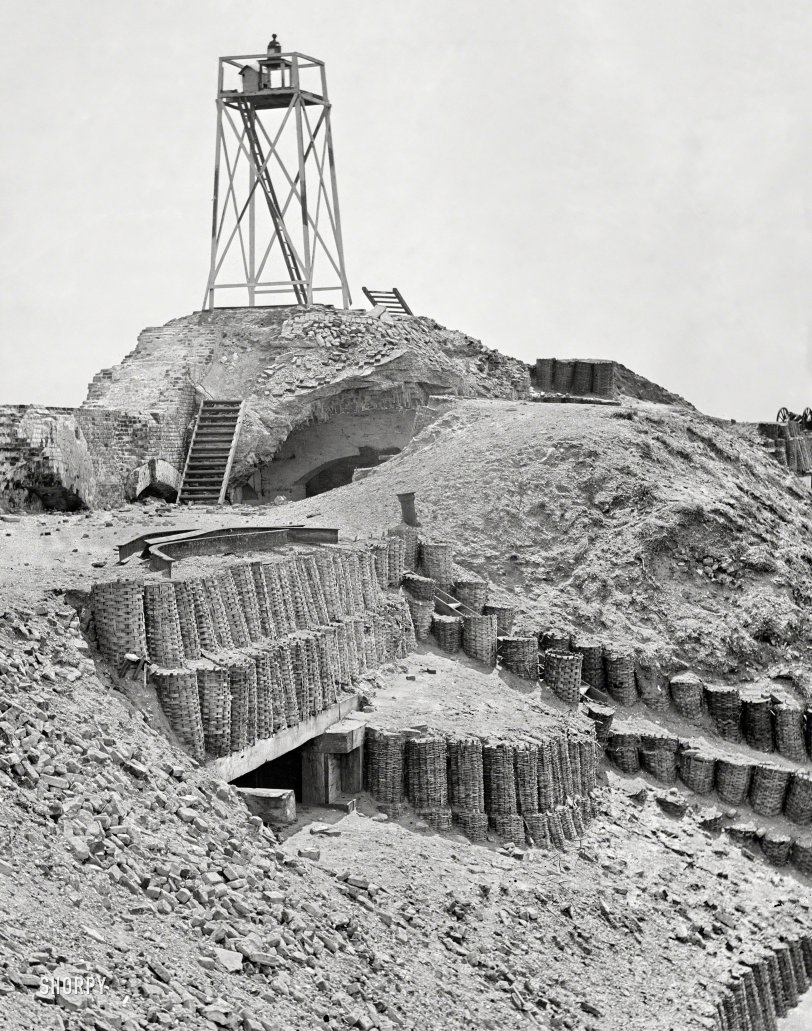


Framed or unframed, desk size to sofa size, printed by us in Arizona and Alabama since 2007. Explore now.
Shorpy is funded by you. Patreon contributors get an ad-free experience.
Learn more.

- Roll your own
- Rugged and real!
- A Charles Purcell - Mama Cass Connection
- Uncle SAAM
- Obfuscation
- One Chocolate Soldier rode away
- Victor Marquis de la Roche
- The Little House Across Way ...
- Vanderbilt Gates
- Vanderbilt Mansion
- You can still see that gate
- Withering heights for me
- So Jim,
- Top Heavy
- Re: Can't Place It.
- Bus ID
- Since you mention it
- The White Pages ?
- Moonlight Tower
- 1907?
- Fire(men) and Water
- Can't Place It
- Can anyone
- Wings
- Where's Claudette and Clark?
- Overbuilt Rolodex
- One song
- Give Me Wings Please!
- PRR
- Pinball Wizards
Printporium
The Parapet: 1865

1865. Charleston, South Carolina. "Beacon on parapet of Fort Sumter." The light at the end of the charnel. Wet plate negative by Samuel A. Cooley. View full size.
HESCOS
The wicker baskets look like HESCOS currently in use by US troops around the world. Amazing how some things never change.
Not Quite Cut Off
Though stuck out in the middle of the harbor, Sumter was not isolated from Charleston. Boats ran regularly between the fort and the city. In fact, the Yankee gunboats couldn't get into the harbor and until fairly late in the War blockade runners were still sneaking in and out. I'm not saying that there were never any homing pigeons used, but I've never seen any reference to any. The fort never surrendered but was abandoned since Charleston was captured from the land side. Although heavily shelled for 3 years and assaulted by naval infantry it held out against everything thrown against it and actually sank one of the gunboats (Keokuk). Part of this was due to the nature of the fort. It started life as a masonry structure designed to withstand cannonball fired by smoothbore artillery. Most of the naval artillery used against it was composed of heavy rifled guns firing much heavier projectiles including chilled nose shot and percussion shells which really did a number on those brick walls. What resulted was a lot of loose rubble and that in conjunction with sand bags, sand and rock filled gabions, absorbed much more punishment than the old time masonry could and this also reduced casualties. That being said, the garrison still suffered greatly throughout the siege.
C-Cubed I
Surely, the basket-like things are gabions -- 19th century equivalent of sandbags to reinforce the fortifications against artillery attack.
And the house-like object on the tower, to the left of the table with the lantern? Could it be a barracks for homing pigeons? Fort Sumter is on an island in Charleston Harbor, if I remember correctly, and Charleston was blockaded by the Union Navy for most of the war. Communicating with the island would be difficult once it was sealed off from boats coming from the mainland.
Of course, Fort Sumter was captured by the Confederates early in the war after a fairly short siege, whose opening shots were the first fired in the Civil War. The Confederates hung onto it till essentially the end of the war in spite of heavy Union attacks by ironclads and landing forces in small boats.
Fort Sumter Range
The successor to this light became the rear light of the Fort Sumter range around 1900; the coast guard historical page claims this was the front light of a range which used a church steeple as the rear, but it's not marked on the charts and given the distance between the two it's not that plausible. At any rate around 1950 they moved it all off the fort because the park service wanted it gone. There's still a Fort Sumter range marking the entrance channel to Charleston harbor, but not on the fort itself.
























On Shorpy:
Today’s Top 5